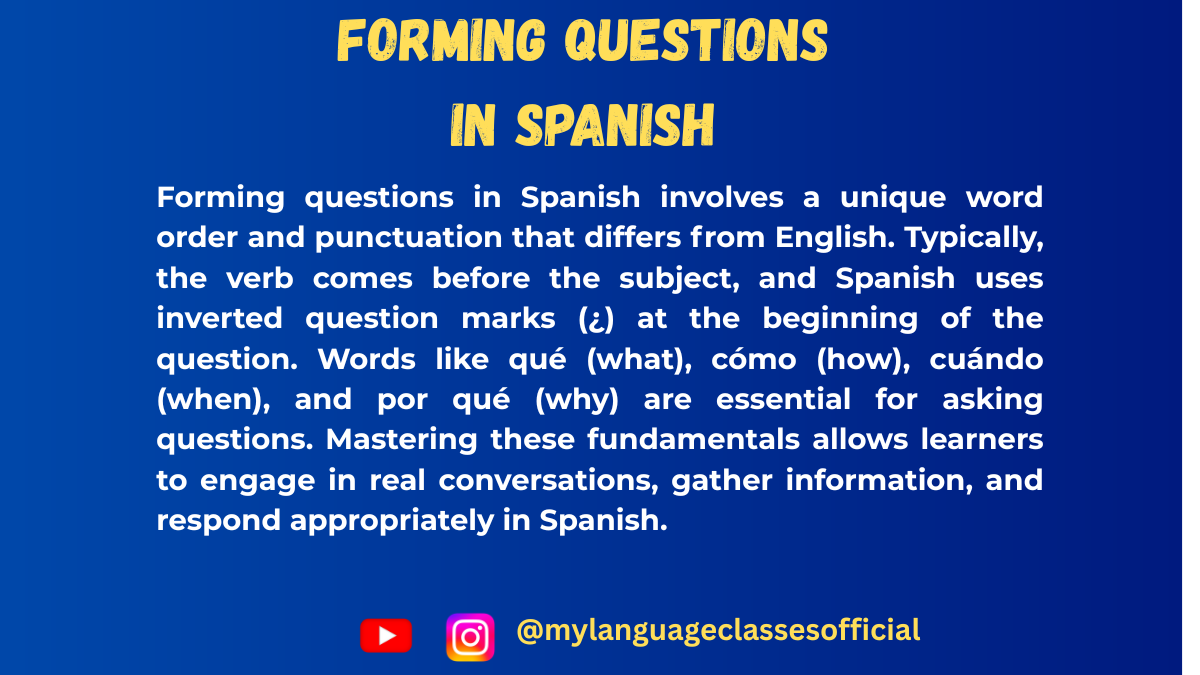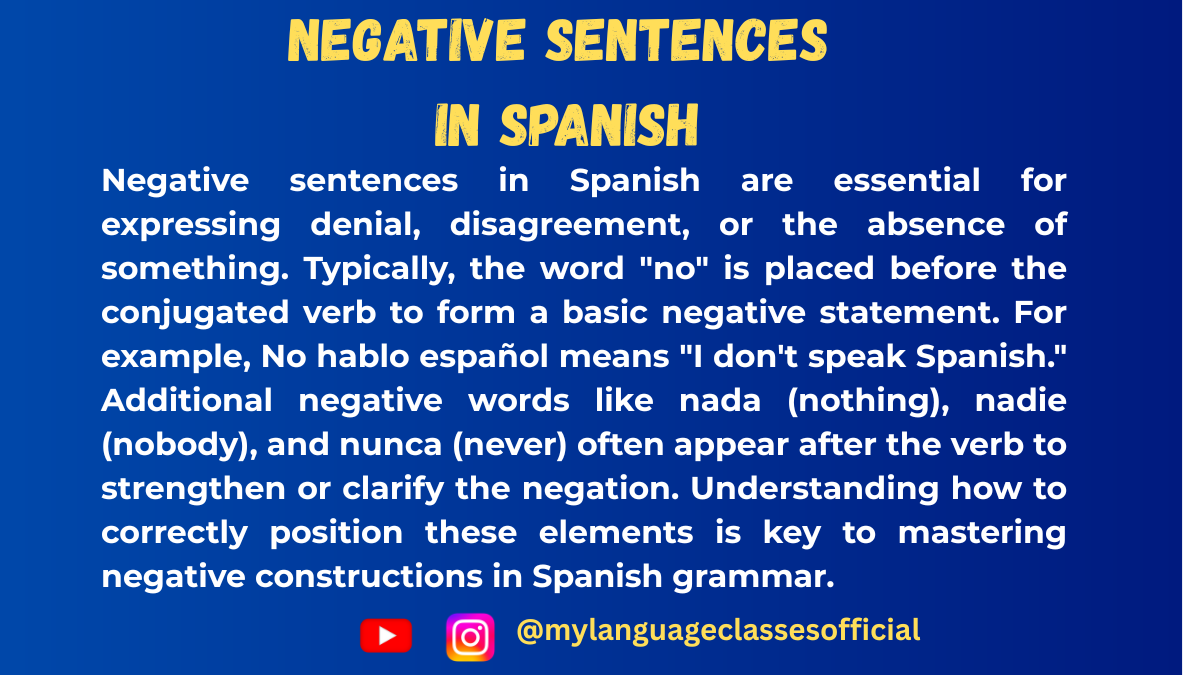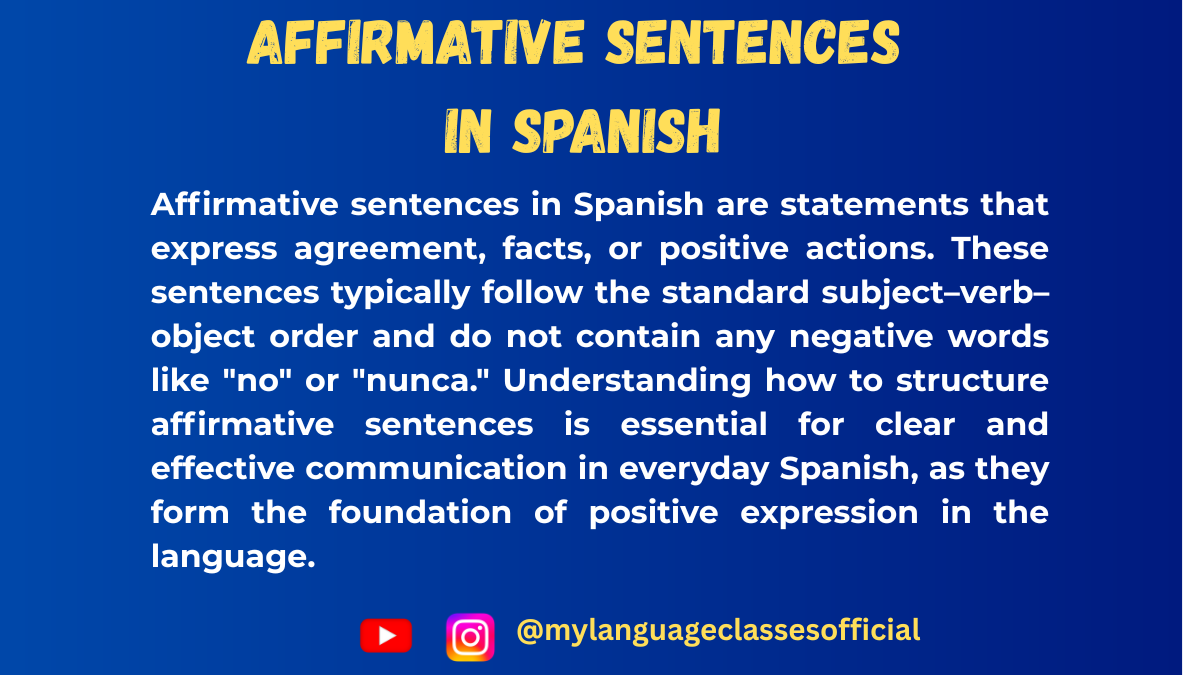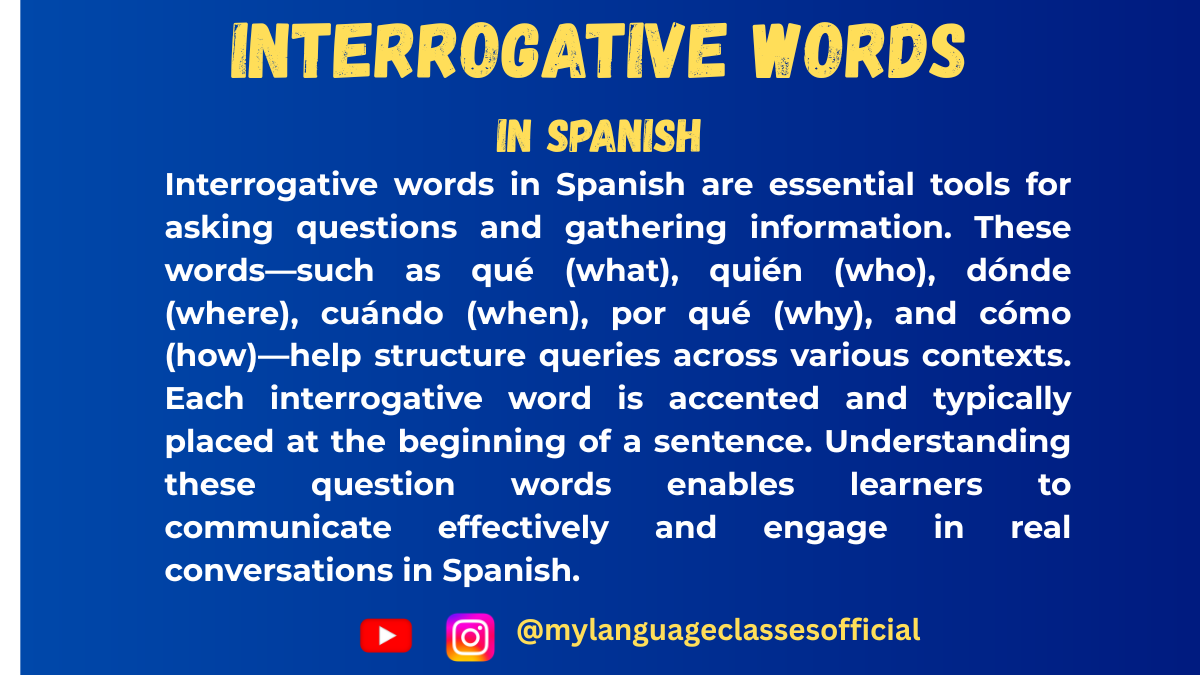Your cart is currently empty!
Category: Sentence Structures and Clauses in Spanish
Learn how to build clear, correct sentences with Spanish sentence structures and clauses. Understand simple, compound, and complex sentence forms, and how independent and dependent clauses work in Spanish grammar. Ideal for learners who want to write and speak more fluently and naturally.
-

Forming Questions in Spanish
Forming Questions in Spanish
Forming questions in Spanish is essential for effective communication. Whether you’re asking for directions, ordering food, or getting to know someone, mastering this skill will help you express yourself confidently. In this post, we’ll explore the most common question words, how to structure questions, and important grammatical details to keep in mind.
Commonly Used Question Words in Spanish
Here’s a list of essential question words in Spanish, their meanings, and examples of usage:
- ¿Qué? – What?
- Example: ¿Qué quieres comer? (What do you want to eat?)
- ¿Quién? / ¿Quiénes? – Who?
- Example (singular): ¿Quién llamó? (Who called?)
- Example (plural): ¿Quiénes son tus amigos? (Who are your friends?)
- ¿Dónde? – Where?
- Example: ¿Dónde vives? (Where do you live?)
- ¿Cuándo? – When?
- Example: ¿Cuándo es la reunión? (When is the meeting?)
- ¿Por qué? – Why?
- Example: ¿Por qué estudias español? (Why are you studying Spanish?)
- ¿Cómo? – How?
- Example: ¿Cómo estás? (How are you?)
- ¿Cuál? / ¿Cuáles? – Which?
- Example (singular): ¿Cuál es tu color favorito? (Which is your favorite color?)
- Example (plural): ¿Cuáles son tus libros? (Which ones are your books?)
- ¿Cuánto? / ¿Cuánta? / ¿Cuántos? / ¿Cuántas? – How much? / How many?
- Example (masculine singular): ¿Cuánto cuesta? (How much does it cost?)
- Example (feminine singular): ¿Cuánta agua necesitas? (How much water do you need?)
- Example (masculine plural): ¿Cuántos días quedan? (How many days are left?)
- Example (feminine plural): ¿Cuántas personas hay? (How many people are there?)
- ¿Para qué? – What for?
- Example: ¿Para qué sirve esto? (What is this for?)
- ¿De quién? / ¿De quiénes? – Whose?
- Example (singular): ¿De quién es este libro? (Whose book is this?)
- Example (plural): ¿De quiénes son estas mochilas? (Whose backpacks are these?)
Key Grammar Points to Remember
- Inverted Question Marks:
Always start your questions with an inverted question mark (¿) in Spanish.
Example: ¿Cómo te llamas? (What is your name?) - Gender and Number Agreement:
- Question words like cuánto, cuánta, cuántos, and cuántas must agree in gender and number with the noun they refer to.
- Masculine singular: ¿Cuánto dinero tienes? (How much money do you have?)
- Feminine plural: ¿Cuántas flores hay en el jardín? (How many flowers are in the garden?)
- Question words like cuánto, cuánta, cuántos, and cuántas must agree in gender and number with the noun they refer to.
- Verb Placement:
In Spanish, the verb typically follows the question word:- Example: ¿Qué haces? (What are you doing?)
- Articles with Nouns:
When a question involves a noun, the correct article must be used to agree with the gender and number:- Example: ¿Qué opinas del libro? (What do you think about the book?)
- Direct and Indirect Questions:
Direct questions use the question word, while indirect ones introduce the question word within a statement:- Direct: ¿Dónde está la estación? (Where is the station?)
- Indirect: No sé dónde está la estación. (I don’t know where the station is.)
- Intonation in Yes/No Questions:
For yes/no questions, intonation can replace question words.- Statement: Tú vienes mañana. (You are coming tomorrow.)
- Question: ¿Tú vienes mañana? (Are you coming tomorrow?)
Things to Keep in Mind
- Politeness: Use polite structures when needed, like adding por favor (please) or using formal pronouns (usted).
- Example: ¿Podría decirme dónde está el baño? (Could you tell me where the bathroom is?)
- Regional Variations:
Some question structures and vocabulary may vary between Spanish-speaking countries. For instance:- Spain: ¿Cómo te llamas? (What is your name?)
- Mexico: ¿Cuál es tu nombre? (What is your name?)
- Practice Contextual Use:
Try forming questions based on real-life situations, such as asking for directions:- ¿Dónde está el mercado? (Where is the market?)
Practice Exercise
Translate these English questions into Spanish:
- What time is it?
- Where are you from?
- Who is coming to the party?
- How much does it cost?
- Why are you late?
Check your answers and practice saying them aloud to improve your fluency.
By understanding these basics and practicing consistently, you’ll soon master the art of forming questions in Spanish. ¡Buena suerte! (Good luck!)
If you found this guide helpful, I’d love to hear from you! Share your thoughts in the comments below or connect with me on social media. For more tips, resources, and inspiration, visit my blog at mylanguageclasses.in. Follow on Instagram and subscribe on YouTube
📚 Continue Learning Spanish
- ¿Qué? – What?
-

Negative Sentences in Spanish
Negative Sentences in Spanish
When learning Spanish, mastering negative sentences is essential for effective communication. Negative sentences allow you to deny, contradict, or express the absence of something. This blog post will guide you through the rules, structures, and common considerations when constructing negative sentences in Spanish, including gender, articles, and plurals.
Basic Structure of Negative Sentences
In Spanish, the word “no” is the key to forming negative sentences. It is placed before the verb.
Examples:
- Affirmative: María canta bien. (María sings well.)
- Negative: María no canta bien. (María does not sing well.)
The structure is straightforward:
Subject + “no” + verb + complement.
Using Negative Words
In Spanish, additional negative words reinforce or replace “no.” These include:
- nada (nothing)
- nadie (nobody)
- ningún/ninguno/ninguna (none, no one)
- nunca (never)
- tampoco (neither)
Double Negatives
Unlike English, double negatives are not only acceptable but required in Spanish. For instance:
- No veo nada. (I don’t see anything.)
- No conozco a nadie. (I don’t know anyone.)
- No estudio nunca. (I never study.)
Here, “no” works in harmony with other negative words.
Gender and Plural Considerations
1. Gender Agreement
Negative words like ninguno and ninguna must agree with the gender of the noun they modify.
- Masculine singular:
No tengo ningún problema. (I don’t have any problem.) - Feminine singular:
No tengo ninguna idea. (I don’t have any idea.)
2. Plural Agreement
In most cases, ninguno is not pluralized, except in specific cases like inherently plural nouns:
- No tengo ningunas vacaciones este año. (I don’t have any vacations this year.)
Position of Negative Words
1. Before the Verb
Negative words like “no” are typically placed before the verb:
- No quiero comer. (I don’t want to eat.)
2. After the Verb
Other negative words may follow the verb for emphasis:
- No quiero nada. (I don’t want anything.)
If a subject pronoun is omitted (common in Spanish), pay attention to word order:
- Nadie sabe la respuesta. (Nobody knows the answer.)
Common Mistakes to Avoid
- Forgetting Double Negatives
Avoid translating English structures directly. Saying No sé algo instead of No sé nada is incorrect. - Ignoring Gender and Number Agreement
Ensure that words like ninguno/ninguna match the noun’s gender and number. - Mixing Articles Incorrectly
When using negative words, omit definite articles unless emphasizing specificity:
- Incorrect: No tengo la idea.
- Correct: No tengo idea.
Practical Tips
- Practice with Examples
Write affirmative and negative versions of sentences:
- Ella siempre llega a tiempo. (She always arrives on time.)
- Ella nunca llega a tiempo. (She never arrives on time.)
- Use Context to Choose Negative Words
- Use nada for “nothing” or “anything.”
- Use nadie when referring to “nobody” or “anybody.”
- Practice Conversations
Create scenarios to apply double negatives naturally:
- No tengo nada que decir. (I have nothing to say.)
Mastering negative sentences in Spanish opens up new possibilities for nuanced communication. Practice regularly, pay attention to gender and number agreement, and soon, negatives will become second nature.
¡Buena suerte! (Good luck!)
If you found this guide helpful, I’d love to hear from you! Share your thoughts in the comments below or connect with me on social media. For more tips, resources, and inspiration, visit my blog at mylanguageclasses.in. Follow on Instagram and subscribe on YouTube
📚 Continue Learning Spanish
-

Affirmative Sentences in Spanish
Affirmative Sentences in Spanish
Affirmative sentences in Spanish are the backbone of everyday communication. They help you convey basic facts, express opinions, and share information. In this blog post, we’ll break down the structure of affirmative sentences, explore key grammar rules, and cover essential points related to gender, pluralization, and the use of articles.
What Are Affirmative Sentences?
Affirmative sentences are straightforward statements that assert or affirm something. For example:
- Yo tengo un perro. (I have a dog.)
- Ellos están felices. (They are happy.)
These sentences contrast with negative sentences (No tengo un perro) and questions (¿Tienes un perro?).
Basic Structure of Affirmative Sentences
In Spanish, the standard sentence structure follows this order:
Subject + Verb + ComplementExamples:
- Ella canta una canción. (She sings a song.)
- Nosotros leemos libros en la biblioteca. (We read books in the library.)
Although Spanish word order can sometimes be flexible for stylistic reasons, this is the default format.
Key Grammar Points for Affirmative Sentences
1. Gender and Number Agreement
In Spanish, nouns and adjectives must agree in gender (masculine/feminine) and number (singular/plural).
- Masculine nouns often end in -o (e.g., niño – boy) and feminine nouns in -a (e.g., niña – girl).
- Adjectives also change based on gender and number.
- Singular: El perro negro (The black dog).
- Plural: Los perros negros (The black dogs).
2. Use of Definite and Indefinite Articles
Articles are essential in Spanish affirmative sentences.
- Definite Articles (the):
- Singular: el (masculine), la (feminine)
- Plural: los (masculine), las (feminine)
Example: El libro está en la mesa. (The book is on the table.)
- Indefinite Articles (a, an, some):
- Singular: un (masculine), una (feminine)
- Plural: unos (masculine), unas (feminine)
Example: Tengo una idea. (I have an idea.)
3. Regular vs. Irregular Verbs
Verbs in Spanish can be regular or irregular. Pay attention to conjugation based on the subject.
- Regular verb example:
Yo hablo español. (I speak Spanish.) - Irregular verb example:
Ella tiene un hermano. (She has a brother.)
4. Pronoun Usage
In Spanish, subject pronouns (yo, tú, él/ella, nosotros, vosotros, ellos/ellas) are often optional. The verb conjugation usually makes the subject clear.
- Yo como manzanas. = Como manzanas. (I eat apples.)
Examples of Affirmative Sentences in Context
Here’s how affirmative sentences work with different grammatical rules:
- Singular and Plural
- Singular: El niño juega en el parque. (The boy plays in the park.)
- Plural: Los niños juegan en el parque. (The boys play in the park.)
- Gender Agreement
- Masculine: Un profesor simpático enseña la clase. (A nice professor teaches the class.)
- Feminine: Una profesora simpática enseña la clase. (A nice female professor teaches the class.)
- Verb Conjugations
- Regular: Nosotros aprendemos español. (We learn Spanish.)
- Irregular: Yo voy al supermercado. (I go to the supermarket.)
- Complex Sentences
- Ellos están comiendo en el restaurante italiano. (They are eating at the Italian restaurant.)
Tips for Forming Affirmative Sentences
- Practice Verb Conjugations: Learn the present tense conjugation of regular verbs (-ar, -er, -ir) and memorize irregular ones.
- Master Articles and Agreement: Always match articles and adjectives with the gender and number of the noun.
- Expand Vocabulary: Build your vocabulary with common nouns, adjectives, and verbs to create diverse sentences.
- Practice Speaking: Use affirmative sentences in daily conversations to build fluency.
Common Mistakes to Avoid
- Skipping Gender and Number Agreement:
- Incorrect: La casa blancos.
- Correct: La casa blanca.
- Incorrect Article Usage:
- Incorrect: Un agua fría.
- Correct: Una agua fría. (Water is feminine, even though it begins with a stressed “a.”)
- Overusing Pronouns:
- Not necessary: Yo voy al cine.
- Better: Voy al cine.
Practice Exercises
- Convert these phrases to plural:
- El gato está en la casa.
- Una flor roja decora la mesa.
- Match the adjective to the noun:
- El coche (rojo/roja).
- Las niñas (inteligentes/inteligente).
- Conjugate the verb:
- Nosotros (hablar) español.
- Ella (comer) una manzana.
Conclusion
Understanding affirmative sentences is crucial for building confidence in Spanish. By mastering the rules of sentence structure, verb conjugations, and gender and number agreement, you’ll be well on your way to expressing yourself clearly and fluently.
Practice regularly, and don’t hesitate to immerse yourself in conversations or writing exercises. ¡Buena suerte! (Good luck!)
If you found this guide helpful, I’d love to hear from you! Share your thoughts in the comments below or connect with me on social media. For more tips, resources, and inspiration, visit my blog at mylanguageclasses.in. Follow on Instagram and subscribe on YouTube
📚 Continue Learning Spanish

